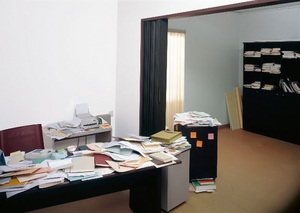This is an archive of the ArtCat Zine, 2007-2009. Please visit our new project, IDIOM.
Thomas Demand at 303 Gallery
Yellowcake
Thomas Demand
303 Gallery - 525 W. 22 St, New York NY
3 November - 22 December 2007
Yellowcake, the show currently open at 303 gallery, marks something of a departure for Thomas Demand. In the past the artist has largely confined himself to images already in some sort of circulation, often ones that he has himself encountered elsewhere. His technique of recreating, in cardboard and paper, a given photograph's subject, and photographing it afresh, so to speak, has thus chiefly served to intervene and complicate an already operative sector of the representational economy. In this way, Barn (1997) simultaneously highlights the seams on the construction that is 'Jackson Pollack,' and what that same signifier manages to leave out, presenced here, perhaps, by the light pouring in the windows and pooling on the floor.
The consistently satisfying thing about this delicate dance of absence and presence running through Demand's work is that it's meticulously reflected in his methodology. Rather than simply gesturing, as many do, towards a body of ideas regarding structure, construct, representation, and the like, Demand takes no chances, producing for our consumption the entire spectacular cycle - each and every time. This diligence prevents him from merely rehearsing the parable of the photo under late capitalism, say, or glossily demonstrating yet again the numerous deceits of official history. Instead, this commitment allows him to set these truths to work on lived experience, returning it to us more estranged, and thus, more familiar, than before.
What makes Yellowcake such a departure for Demand, and what makes it so compelling, is that he has chosen for his subject something which is not only outside the dominant economy, but strategically so, such that its appearance in ordinary photographs alone constitutes a sufficient presentation in the hands of a lesser artist. This imagery would no doubt seek to supplement the fraudulent discourse regarding the American invasion of Iraq with actual, documentary photos of Niger's Embassy in Rome; from which the letterhead used to fabricate the evidence of Hussein's alleged attempt to purchase of weapons grade uranium (yellowcake) was stolen. In Demand's hands, however, this act of demonstration, this voici, is much more complicated than any simple speaking of truth to power.
For in creating Yellowcake, Demand chose not to work from actual images to create his embassy sculptures, as he had previously, using instead his personal recollections of the place, to which he had gained access. Thus with a subject most in need of documentation, Demand chose not to document it at all, even for the simple purposes of his own eventual translation. Hence these images still do not exist, and any effort to take Demand's show as attempting to provide these bits of evidence is tripped up. Yellowcake then appears as Demand focusing for the first time on the nature and veracity of his own method, divorced, for the first time, from any relationship to imagery already at work. But this is not a simple navel-gazing exercise on his part. By choosing this location for reconstruction (that is outside the official accounting, but shouldn't be) limiting our access to his own potentially unreliable memories, and then beginning his well-established process of material construction and image-making, Demand foregrounds a certain transition that comes with his stepping into this particular fray.
Or, to put it another way, it is precisely because this setting is most in need of photographic evidence that Demand pushes the constraints of that need farther from him. And, in this way, he highlights in blazing colors the operation of political power on the provisioning of evidence but does so from the other side, so that we might see it more clearly. Thus we, being where we are, which is in the 303 gallery in New York, wanting nothing more than hard evidence of the current regimes continued ontological bankruptcy, are presented with a representation of what this evidence would indeed look like, only to find that it bears the same scars of contingency and haphazardness as the very narrative we are trying to resist. (The embassy's a mess.) It is not that Demand is saying that we are no better than our foes, or that any attempt at providing honest, corrective accounts is doomed to repeat their mistakes — rather he is reminding us of the oblique torque of politics on the praxis of representation. By departing from his method when we should most want him to maintain it, Demand not only recharges the empty spaces of his own presentation — making each blank sheet of paper a different sort of question than they were in his previous Office (1995) — but he also cautions us about abandoning our own commitments for the purposes of scoring political points in a vulgar game. For the effects of this forgetting, at least, he is happy to provide evidence.
ZINE
HOME
TIPS / COMMENTS
CATEGORIES
CONTRIBUTORS
- Greg Afinogenov
- B. Blagojevic
- Adda Birnir
- Susannah Edelbaum
- Julie Fishkin
- Paddy Johnson
- Jessica Loudis
- Christopher Reiger
- Andrew Robinson
- Peter J. Russo
- Blythe Sheldon
- S.C.Squibb
- Hrag Vartanian

